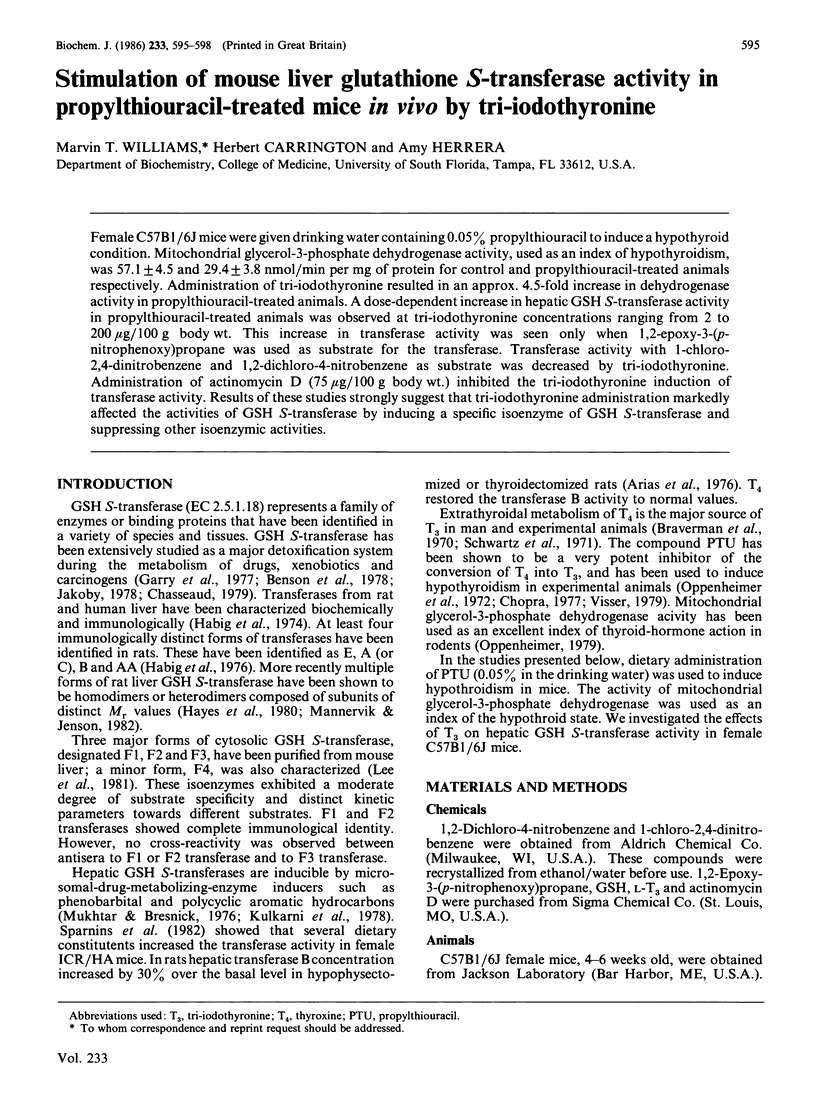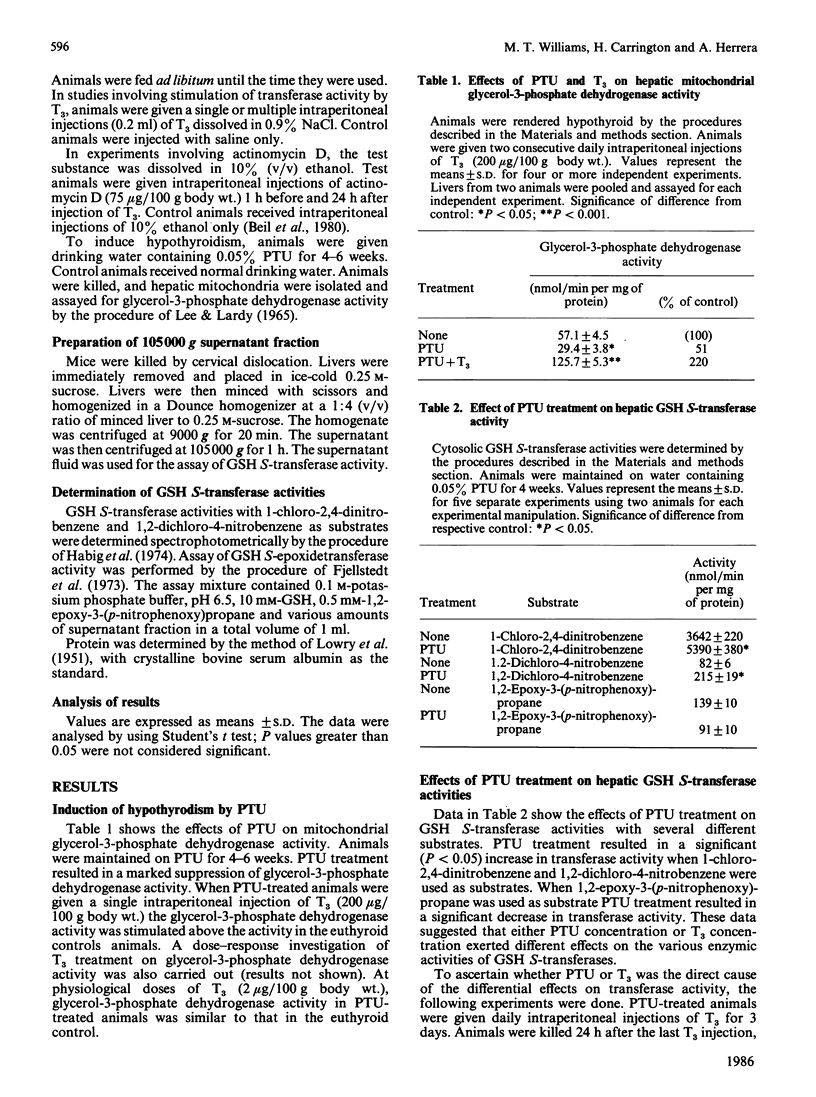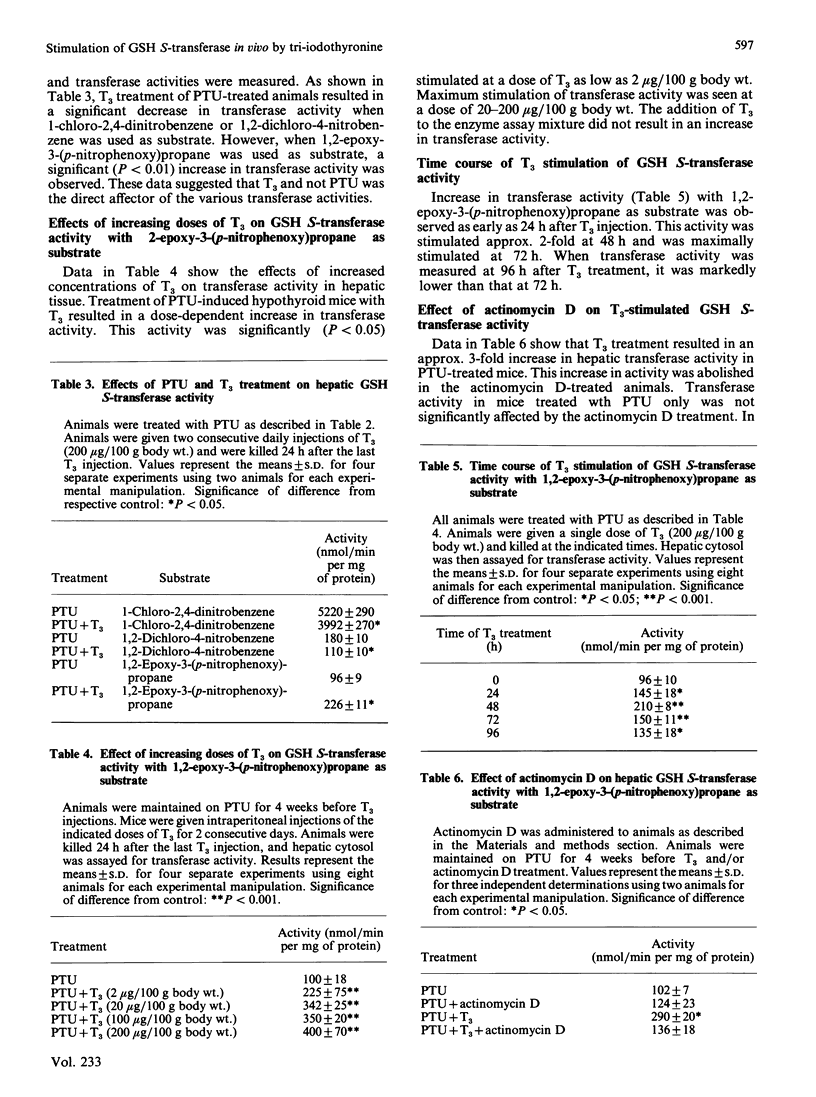Abstract
Female C57Bl/6J mice were given drinking water containing 0.05% propylthiouracil to induce a hypothyroid condition. Mitochondrial glycerol-3-phosphate dehydrogenase activity, used as an index of hypothyroidism, was 57.1 +/- 4.5 and 29.4 +/- 3.8 nmol/min per mg of protein for control and propylthiouracil-treated animals respectively. Administration of tri-iodothyronine resulted in an approx. 4.5-fold increase in dehydrogenase activity in propylthiouracil-treated animals. A dose-dependent increase in hepatic GSH S-transferase activity in propylthiouracil-treated animals was observed at tri-iodothyronine concentrations ranging from 2 to 200 micrograms/100 g body wt. This increase in transferase activity was seen only when 1,2-epoxy-3-(p-nitrophenoxy)propane was used as substrate for the transferase. Transferase activity with 1-chloro-2,4-dinitrobenzene and 1,2-dichloro-4-nitrobenzene as substrate was decreased by tri-iodothyronine. Administration of actinomycin D (75 micrograms/100 g body wt.) inhibited the tri-iodothyronine induction of transferase activity. Results of these studies strongly suggest that tri-iodothyronine administration markedly affected the activities of GSH S-transferase by inducing a specific isoenzyme of GSH S-transferase and suppressing other isoenzymic activities.
Full text
PDF



Selected References
These references are in PubMed. This may not be the complete list of references from this article.
- Beil W., Kahl R., Kahl G. F. Circadian rhythm of the inhibitory effect of actinomycin D on cytochrome P-448 induction by 3-methylcholanthrene. Biochem Pharmacol. 1980 Apr 15;29(8):1201–1204. doi: 10.1016/0006-2952(80)90419-0. [DOI] [PubMed] [Google Scholar]
- Benson A. M., Batzinger R. P., Ou S. Y., Bueding E., Cha Y. N., Talalay P. Elevation of hepatic glutathione S-transferase activities and protection against mutagenic metabolites of benzo(a)pyrene by dietary antioxidants. Cancer Res. 1978 Dec;38(12):4486–4495. [PubMed] [Google Scholar]
- Braverman L. E., Ingbar S. H., Sterling K. Conversion of thyroxine (T4) to triiodothyronine (T3) in athyreotic human subjects. J Clin Invest. 1970 May;49(5):855–864. doi: 10.1172/JCI106304. [DOI] [PMC free article] [PubMed] [Google Scholar]
- Chasseaud L. F. The role of glutathione and glutathione S-transferases in the metabolism of chemical carcinogens and other electrophilic agents. Adv Cancer Res. 1979;29:175–274. doi: 10.1016/s0065-230x(08)60848-9. [DOI] [PubMed] [Google Scholar]
- Chopra I. J. A study of extrathyroidal conversion of thyroxine (T4) to 3,3',5-triiodothyronine (T3) in vitro. Endocrinology. 1977 Aug;101(2):453–463. doi: 10.1210/endo-101-2-453. [DOI] [PubMed] [Google Scholar]
- Fjellstedt T. A., Allen R. H., Duncan B. K., Jakoby W. B. Enzymatic conjugation of epoxides with glutathione. J Biol Chem. 1973 May 25;248(10):3702–3707. [PubMed] [Google Scholar]
- Goldberg I. H., Friedman P. A. Antibiotics and nucleic acids. Annu Rev Biochem. 1971;40:775–810. doi: 10.1146/annurev.bi.40.070171.004015. [DOI] [PubMed] [Google Scholar]
- Habig W. H., Jakoby W. B., Guthenberg C., Mannervik B., Vander Jagt D. L. 2-Propylthiouracil does not replace glutathione for the glutathione transferases. J Biol Chem. 1984 Jun 25;259(12):7409–7410. [PubMed] [Google Scholar]
- Habig W. H., Pabst M. J., Jakoby W. B. Glutathione S-transferase AA from rat liver. Arch Biochem Biophys. 1976 Aug;175(2):710–716. doi: 10.1016/0003-9861(76)90563-4. [DOI] [PubMed] [Google Scholar]
- Habig W. H., Pabst M. J., Jakoby W. B. Glutathione S-transferases. The first enzymatic step in mercapturic acid formation. J Biol Chem. 1974 Nov 25;249(22):7130–7139. [PubMed] [Google Scholar]
- Hayes J. D., Strange R. C., Percy-Robb I. W. Cholic acid binding by glutathione S-transferases from rat liver cytosol. Biochem J. 1980 Jan 1;185(1):83–87. doi: 10.1042/bj1850083. [DOI] [PMC free article] [PubMed] [Google Scholar]
- Jakoby W. B. The glutathione S-transferases: a group of multifunctional detoxification proteins. Adv Enzymol Relat Areas Mol Biol. 1978;46:383–414. doi: 10.1002/9780470122914.ch6. [DOI] [PubMed] [Google Scholar]
- LEE Y. P., LARDY H. A. INFLUENCE OF THYROID HORMONES ON L-ALPHA-GLYCEROPHOSPHATE DEHYDROGENASES AND OTHER DEHYDROGENASES IN VARIOUS ORGANS OF THE RAT. J Biol Chem. 1965 Mar;240:1427–1436. [PubMed] [Google Scholar]
- LOWRY O. H., ROSEBROUGH N. J., FARR A. L., RANDALL R. J. Protein measurement with the Folin phenol reagent. J Biol Chem. 1951 Nov;193(1):265–275. [PubMed] [Google Scholar]
- Lee C. Y., Johnson L., Cox R. H., McKinney J. D., Lee S. M. Mouse liver glutathione S-transferases. Biochemical and immunological characterization. J Biol Chem. 1981 Aug 10;256(15):8110–8116. [PubMed] [Google Scholar]
- Mannervik B., Jensson H. Binary combinations of four protein subunits with different catalytic specificities explain the relationship between six basic glutathione S-transferases in rat liver cytosol. J Biol Chem. 1982 Sep 10;257(17):9909–9912. [PubMed] [Google Scholar]
- Mukhtar H., Bresnick E. Mouse liver and lung glutathione s-epoxide transferase: effects of phenobarbital and 3-methylcholanthrene administration. Chem Biol Interact. 1976 Sep;15(1):59–67. doi: 10.1016/0009-2797(76)90128-9. [DOI] [PubMed] [Google Scholar]
- Oppenheimer J. H., Schwartz H. L., Surks M. I. Propylthiouracil inhibits the conversion of L-thyroxine to L-triiodothyronine. An explanation of the antithyroxine effect of propylthiouracil and evidence supporting the concept that triiodothyronine is the active thyroid hormone. J Clin Invest. 1972 Sep;51(9):2493–2497. doi: 10.1172/JCI107063. [DOI] [PMC free article] [PubMed] [Google Scholar]
- Oppenheimer J. H. Thyroid hormone action at the cellular level. Science. 1979 Mar 9;203(4384):971–979. doi: 10.1126/science.218285. [DOI] [PubMed] [Google Scholar]
- Schwartz H. L., Surks M. I., Oppenheimer J. H. Quantitation of extrathyroidal conversion of L-thyroxine to 3,5,3'-triiodo-L-thyronine in the rat. J Clin Invest. 1971 May;50(5):1124–1130. doi: 10.1172/JCI106584. [DOI] [PMC free article] [PubMed] [Google Scholar]
- Seelig S., Liaw C., Towle H. C., Oppenheimer J. H. Thyroid hormone attenuates and augments hepatic gene expression at a pretranslational level. Proc Natl Acad Sci U S A. 1981 Aug;78(8):4733–4737. doi: 10.1073/pnas.78.8.4733. [DOI] [PMC free article] [PubMed] [Google Scholar]
- Smith G. J., Ohl V. S., Litwack G. Ligandin, the glutathione S-transferases, and chemically induced hepatocarcinogenesis: a review. Cancer Res. 1977 Jan;37(1):8–14. [PubMed] [Google Scholar]
- Sparnins V. L., Venegas P. L., Wattenberg L. W. Glutathione S-transferase activity: enhancement by compounds inhibiting chemical carcinogenesis and by dietary constituents. J Natl Cancer Inst. 1982 Mar;68(3):493–496. [PubMed] [Google Scholar]
- Visser T. J. Mechanism of action of iodothyronine-5'-deiodinase. Biochim Biophys Acta. 1979 Aug 15;569(2):302–308. doi: 10.1016/0005-2744(79)90066-4. [DOI] [PubMed] [Google Scholar]


